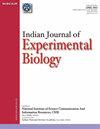炔诺星和炔诺星B通过ROS-p38信号通路增强吉西他滨对Panc-1细胞的抗肿瘤活性
IF 0.7
4区 生物学
Q4 BIOLOGY
引用次数: 0
摘要
胰腺导管腺癌(PDAC)是最恶性的肿瘤之一,对PDAC的有效治疗干预是有限的。虽然Corynoxine(Cory)及其异构体Cory B已被鉴定为神经元细胞中的自噬诱导剂,但尚不清楚它们是否对PDAC具有治疗作用。在此,我们进行了细胞计数试剂盒-8(CCK8)、集落形成、5-乙炔基-2′-脱氧尿苷(EDU)染色、TUNEL和流式细胞术测定,以评估Cory对PDAC的影响。进行蛋白质印迹以分析蛋白质表达水平。我们发现Cory和Cory B增强了吉西他滨(Gem)对Gem抗性Panc-1细胞的细胞生长停滞和促凋亡作用。机制研究表明,活性氧(ROS)产生和p38激活的增加与Cory和Cory B诱导的细胞死亡密切相关。ROS清除剂N-乙酰半胱氨酸预处理阻断了Cory和Cory B诱导的细胞死亡。此外,p38抑制剂SB203580阻止了Cory和Cory B诱导的细胞死亡。总体而言,Cory和科里B通过激活ROS依赖性p38信号通路增加了Gem抗性Panc-1细胞对Gem的敏感性。我们的研究结果表明,Cory和Cory B可能是PDAC治疗的潜在方法。本文章由计算机程序翻译,如有差异,请以英文原文为准。
Corynoxine and corynoxine B enhance the antitumor activity of gemcitabine in Panc-1 cells via ROS-p38 signaling pathway
Pancreatic ductal adenocarcinoma (PDAC) is one of the most malignant tumors, and effective therapeutic interventions for PDAC are limited. While Corynoxine (Cory) and its isomer Cory B have been identified as autophagy inducers in neuronal cells, it remains unclear whether they exert a therapeutic effect on PDAC. Here, we performed cell counting kit-8 (CCK8), colony formation, 5-Ethynyl-2′-deoxyuridine (EDU) staining, TUNEL, and flow cytometry assays to evaluate the effects of Cory on PDAC. Western blotting was conducted to analyze the protein expression levels. We showed that Cory and Cory B enhanced cell growth arrest and pro-apoptotic effects of gemcitabine (Gem) on Gem-resistant Panc-1 cells. Mechanistic studies revealed that increased production of reactive oxygen species (ROS) and p38 activation were closely associated with Cory and Cory B-induced cell death. Pretreatment with ROS scavenger N-acetylcysteine blocked Cory and Cory B-induced cell death. Moreover, p38 inhibitor SB203580 prevented cell death induced by Cory and Cory B. Overall, Cory and Cory B increase the sensitivity of Gem-resistant Panc-1 cells to Gem through the activation of ROS-dependent p38 signaling pathway. Our results indicate that Cory and Cory B might be potential approaches for PDAC therapy.
求助全文
通过发布文献求助,成功后即可免费获取论文全文。
去求助
来源期刊
CiteScore
1.57
自引率
33.30%
发文量
84
审稿时长
6 months
期刊介绍:
This journal, started in 1963, publishes full papers, notes and reviews in cell biology, molecular biology, genetic engineering, endocrinology, reproductive biology, immunology, developmental biology, comparative physiology, radiation biology, chronobiology, microbiology, pharmacology, toxicology and other biological fields including instrumentation and methodology. The papers having experimental design involving alteration and/or manipulation in biological system(s) providing insight into their functioning are considered for publication. Studies involving higher animals, human beings and of clinical nature are not encouraged for publication in the journal.

 求助内容:
求助内容: 应助结果提醒方式:
应助结果提醒方式:


